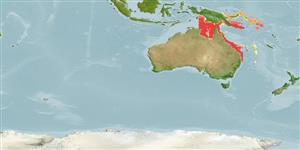>
Eupercaria/misc (Various families in series Eupercaria) >
Nemipteridae (Threadfin breams, Whiptail breams)
Etymology: Pentapodus: Greek, pente = five + Greek, pous = feet (Ref. 45335).
More on author: Günther.
Environment: milieu / climate zone / depth range / distribution range
Ecologie
marien rifbewoner; diepte 10 - 70 m (Ref. 90102). Tropical; 3°S - 30°S, 135°E - 165°E (Ref. 3810)
Western Pacific: northeastern Australia, southern Papua New Guinea, Solomon Islands and the Philippines. This species has been previously confused with Pentapodus setosus by most authors.
Grootte / Gewicht / Leeftijd
Maturity: Lm ? range ? - ? cm
Max length : 30.0 cm TL mannelijk / geslacht onbekend; (Ref. 9710); common length : 15.0 cm SL mannelijk / geslacht onbekend; (Ref. 3810)
Dorsale stekels (totaal) : 10; Dorsale zachte stralen (totaal) : 9; Anale stekels: 3; Anale zachte stralen: 7. Head scales reaching forward to or almost to level of posterior nostrils. Suborbital naked. Lower limb of preopercle naked. Pelvic fins short, not reaching to level of anus. Upper lobe of caudal fin produced into a very long trailing yellowish-brown filament. Axillary scale present. Color: Upper body pale brownish, lower whitish. Presence of three bluish stripes across snout, first joining eyes behind nostrils, second in front of nostrils, third from eye to tip of snout. A yellow stripe from behind eye to upper base of pectoral fin. A yellow stripe from middle of upper lip, beneath eye to below pectoral fin.
Found near reefs. Juveniles in rubble areas (Ref. 9710). Solitary or in small groups (Ref. 90102). Feeds on small fishes, crustaceans and polychaetes (Ref. 9785).
Levenscyclus en paargedrag
Maturiteit | Voortplanting | Paaien | Eieren | Fecunditeit | Larven
Russell, B.C., 1990. FAO Species Catalogue. Vol. 12. Nemipterid fishes of the world. (Threadfin breams, whiptail breams, monocle breams, dwarf monocle breams, and coral breams). Family Nemipteridae. An annotated and illustrated catalogue of nemipterid species known to date. FAO Fish. Synop. 125(12):149p. Rome: FAO. (Ref. 3810)
Status op de Rode Lijst van het IUCN (Ref. 130435: Version 2024-2)
Gevaar voor de mens
Harmless
Gebruik door de mens
Visserij: visserij voor eigen gebruik
Tools
Speciale rapporten
Download XML
Internetbronnen
Estimates based on models
Preferred temperature (Ref.
123201): 24.5 - 28, mean 26.5 °C (based on 150 cells).
Fylogenetische diversiteitsindex (Ref.
82804): PD
50 = 0.5002 [Uniqueness, from 0.5 = low to 2.0 = high].
Bayesian length-weight: a=0.01445 (0.00683 - 0.03057), b=2.98 (2.81 - 3.15), in cm total length, based on LWR estimates for this (Sub)family-body shape (Ref.
93245).
Trofisch niveau (Ref.
69278): 3.7 ±0.54 se; based on food items.
Weerstandsvermogen (Ref.
120179): Hoog, minimale populatieverdubbelingstijd minder dan 15 maanden (Preliminary K or Fecundity.).
Fishing Vulnerability (Ref.
59153): Low vulnerability (20 of 100).
Nutrients (Ref.
124155): Calcium = 52.6 [31.8, 103.4] mg/100g; Iron = 0.633 [0.310, 1.558] mg/100g; Protein = 19.1 [17.2, 20.8] %; Omega3 = 0.158 [0.095, 0.265] g/100g; Selenium = 32.1 [19.5, 57.2] μg/100g; VitaminA = 75 [22, 213] μg/100g; Zinc = 1.18 [0.82, 1.68] mg/100g (wet weight);
